Last Updated: 4 months ago
High-quality food can meet the health and physical requirements of a German Shepherd.
GSDs are strong, athletic, and active dogs. They love physical exercise and stay active most of the time.
Due to their energetic nature, these dogs require a power-packed diet. If you want your GSD to be healthy, make sure you are fulfilling its dietary needs.
Let’s explore different food types and our German Shepherd feeding chart.
GSD Nutritional Requirements
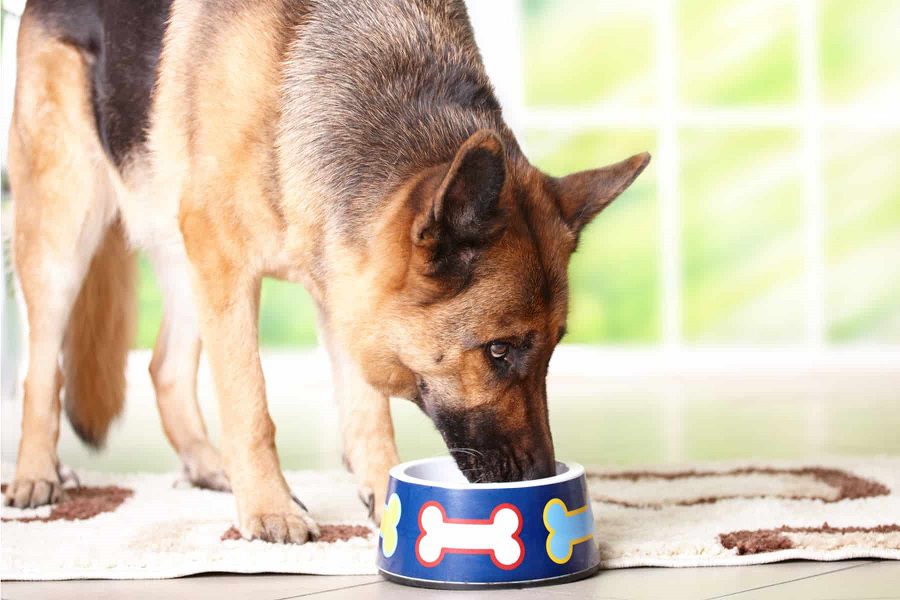
GSDs are carnivores, which means they require a higher content of protein in their diet. This protein is what provides them energy and keeps them strong and healthy.
Protein also plays a vital role in your GSD’s growth, and it is recommended that a GSD get at least 22% of protein in its diet.
It is best to feed pure protein to your dog instead of buying poor-quality dog food that has corn syrup added as a filler, which is extremely harmful to a dog. The other nutritional requirement for a GS is fat.
Fat comes from protein and gives taste to a dog’s meal. However, feeding your dog too many fatty foods will be harmful to its health. On the other hand, if you feed too little fat, it will create a lot of skin problems for your German Shepherd.
Feeding a raw diet at an early age will help your pup grow faster. A raw meat diet is also helpful in strengthening the bones and fighting several diseases in GSDs.
If meat shops are hard to find in your area, US Wellness Meats menu selection offers free shipping for online orders across the state.
Fat content in a dog’s diet also keeps its fur healthy. As a GS sheds a lot of fur throughout the year, it is extremely important that it is given the right amount of fat in its food. The AAFCO recommended fat content for German Shepherds is 5%–8%.
Individual needs of German Shepherds depend on a number of factors, including age, sex, lifestyle, and much more. It is not necessary that the food requirements for a young GS match those of an adult GS.
Sometimes younger German Shepherds require a high-energy diet to keep them active. This is the case with the dogs that live both indoors and outdoors. These dogs also require a diet rich in protein to regulate their body temperature.
Our advice is that you should avoid high-carb foods (dry kibbles). It would be best if you always bought high-protein, grain-free food. That is what the science says, and in our experience, you should obey it.
German Shepherd Puppy Food Requirements
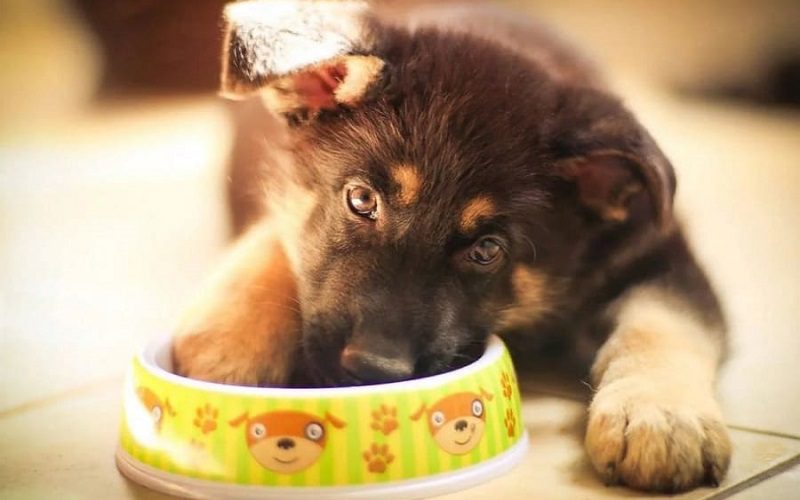
Usually, German Shepherd puppies consume more food than an adult GSD.
The little ones are extremely curious, and because they are exploring their environment most of the time, they need a high-energy diet, which they do several times a day. One additional note: Always keep your puppy food away from their dog beds.
Puppies have seemingly endless energy stores. This means they need a constant supply of calories—the right types of calories—to keep their energy levels high and help them develop into happy, healthy adult dogs.
As a new German Shepherd puppy owner, you’re probably going to have a few questions that need specific answers.
Feeding a puppy is a lot different than feeding an adult dog because you’re usually housebreaking them, so you’ll need to stay on a regular feeding schedule, and their growing bodies require more nutrients from their food than adult dogs do.
They’re all legitimate concerns, and we’re glad you’re taking matters into your own hands instead of just giving them a constant supply of food all day or, worse, potentially starving them of vital nutrients and minerals because you’re not feeding them enough.
As a general rule, you can tell that you’re feeding your puppy too often if you cannot see or feel their rib cage.
While, for humans, this is considered a sign of malnutrition, it’s actually a guideline you can use to help figure out if your puppy is getting enough calories from their diet.
How Often Do You Feed a Puppy?
Young puppies need to eat 3–4 smaller meals each day.
If you must, you can divide the food up into two larger meals, but make sure that you’re not feeding them so much that they’re starting to vomit. Puppies won’t necessarily regulate themselves, as far as stuffing their faces goes, so you’ll need to do it for them.
Puppy food is a lot different than adult food because manufacturers put more emphasis on the different nutrients puppies need while they’re developing their internal, muscular, and skeletal systems.
Once puppies become adult dogs, their nutritional requirements change, meaning you should only feed them food created specifically for puppies (or later, adults).
How many times a day should a dog eat? When your puppy reaches the 6-month mark, you can reduce the number of times they eat each day to one or two.
Below are our instructions for a German Shepherd puppy. Remember, a GS pup’s diet isn’t similar to that of an adult dog.
German Shepherd Feeding Chart Explained
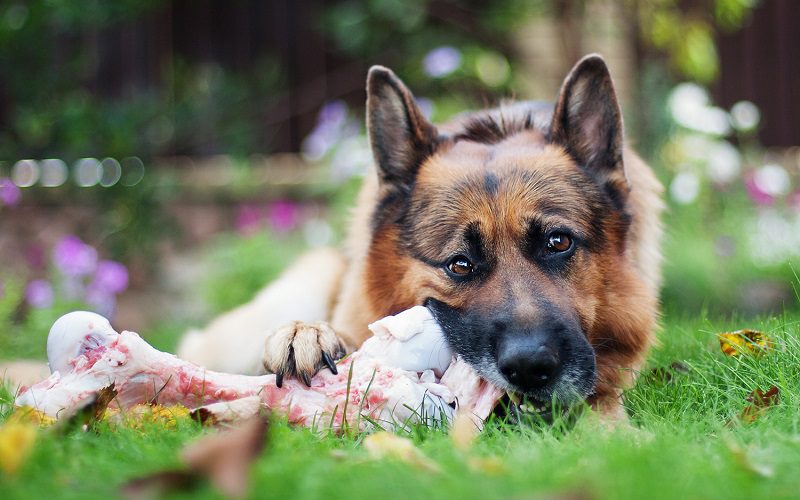
It is important that German Shepherd owners know the amount of food that their dog requires on a daily basis.
Feeding too much or too little can cause health problems in GSDs. If you feed a lot of fat to your pup, it will develop hip dyslexia.
Depending on how you’re deciding to feed your puppy—either a natural, real meat, bone, or vegetable diet—or if you’re giving them off-the-shelf dog food, you’ll want to follow the recommendations below to help ensure they properly develop their internal systems and maintain their energy levels.
Your German Shepherd is going to grow rapidly over their first 12 months of life, so you’re going to want to increase the amount of food they have as they get older.
Ensuring they have the proper amount of nutrition in the proper ratios is critical to their developing into healthy adults.
A 6-weeks-old German Shepherd
At 6 weeks old, your job as a new owner is to make sure that your puppy is receiving the same level of nutrition that they were getting from their mother’s milk.
Ideally, your puppy should still be nursing from their mother, because most foods are going to have a hard time replacing the needed micro and macronutrients, along with the natural antibodies that are found inside of the mother’s milk.
A 10-Week-Old German Shepherd
At 8 to 10 weeks, you can begin weaning them off of their mother and start increasing the amount of puppy food you’re giving them.
It’s best to start with a diet of wet food to help their body adjust to the transition. Wet food contains around 85% moisture, which prepares their digestive system for the whole food coming in the next few weeks.
12-Week-Old German Shepherd
At 12 weeks old, you can begin transitioning them from wet food to dry food. You want to make the transition in small steps to avoid causing excessive diarrhea or vomiting.
To start, mix 10% dry food into the wet food you’re giving them, and then increase it by 10-15% each week after.
A 3-Month-Old German Shepherd
By 3 months old, your puppy should have almost fully transitioned to eating only dry food.
You want to avoid buying foods that are listed for all ages or all growth stages. These are generalized recipes that do not have the nutrition your puppy needs to thrive.
A 4-Month-Old German Shepherd
At 4 months old, you can begin introducing more live animal products into their diet.
Ingredients like actual bone, pieces of liver, and raw eggs are great to help your dog pick up the nutrients that may be lacking in their dry dog food.
Avoid giving them too much, though, by following the guidelines we’ve given you above.
A 5-Month-Old German Shepherd
By 5 months old, your puppy should have adjusted to their new dry food, along with the live food ingredients that you’ve begun giving them.
You’ll also want to cut back on how often you’re feeding them, providing a meal in the morning and one in the afternoon or evening.
A 6-Month-Old German Shepherd
At 6 months of age, you can begin introducing live ingredients into your puppy’s diet.
Ingredients like crushed animal bones, pieces of chopped liver, and raw eggs are all vital to helping your puppy build up natural immunity and provide them with the nutrients that they’re not going to be getting from their dry food diet.
A 8-Month-Old German Shepherd
By 8 months old, you can begin weaning your puppy off of a strictly puppy food diet.
Again, you’ll want to avoid abrupt changes in their diet, instead relying on switching 10% of their new food with 90% of their old food and increasing the proportions by 10% each week until they’ve adjusted.
While you can use foods “for all growth stages,” we still recommend against them because they are generalized, as far as nutrition goes, and try to lump every dog into a one-size-fits-all body.
German Shepherds are different and require different levels of nutrition as they’re growing.
A 1-year-old German Shepherd
At 1 year old, you’ll begin to notice that your dog is actually eating less food than they did when they were younger. This is because their metabolism is beginning to slow down.
You can begin to limit the number of times you feed them to once a day. If they leave food in their bowl, you can cut back on the amount you’re actually giving them.
Different Types of GSD Foods Compared
There are different types of dog foods available on the market. However, commercial food is not very healthy for your German Shepherd dog and has ingredients that may harm your pup’s health.
Make sure you visit your vet and take recommendations on high-quality German Shepherd food.
It might be confusing to decide the type of food you want to feed your German Shepherd. There are a variety of options you can choose from.
However, the biggest debate is: canned or dry? So, how can you differentiate between canned and dry dog food? What is better? Which is the healthier of the two?
You can choose the best option only when you know all about it. GSDs rely on their food to grow and become stronger. If we feed the wrong type of food to our dogs, it will cause them many health problems.
Let us help you differentiate between canned and dry food for your dog.
Dry Food or Kibble
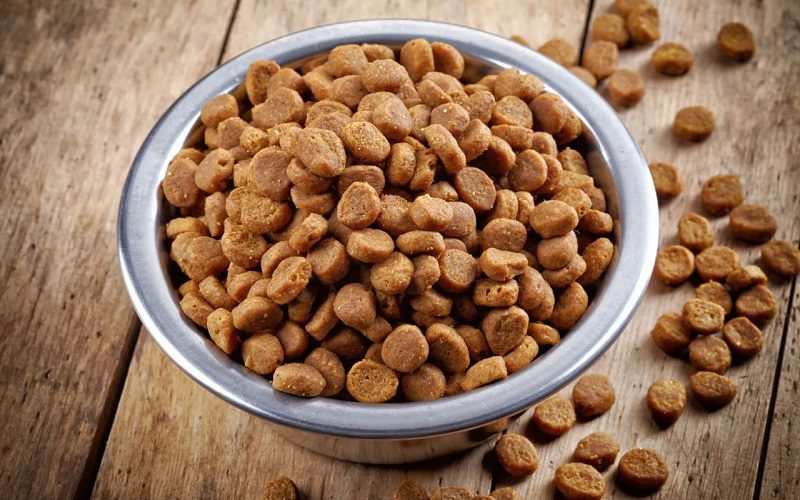
This type of dog food is the most popular type of dog food available on the market. There are several pros to getting this type of food for your GS.
Dry food is convenient, affordable, and greater in quantity. However, there are certain cons to this type of GS food, as it has a very small quantity of water in it. This type of food can cause dehydration and liver problems in your dog.
Expert vets around the world suggest that dog owners feed their pets a moderate diet that comprises both dry and wet food.
Hint: Organic food is becoming more and more popular nowadays.
Advantages of Dry Food
There are certain advantages to dry kibble for your German Shepherd:
- Dry kibble is good for your GSD’s teeth and makes them stronger.
- Dry kibble is easy to get and more convenient to feed than wet or canned food.
- Dry kibble helps reduce plaque and tartar buildup in your dog’s teeth.
- Dry kibble is good for a dog’s oral health.
- Chewing on dry kibble helps your GSD reduce its stress and kill the urge to chew on your shoes and furniture.
- Dry kibble is easy to contain and preserve, as it doesn’t need to be placed in the refrigerator after it is opened.
- Dry kibble lasts longer than canned food.
- It is easy to take dry kibble from one place to another.
- Dry kibble is more affordable than canned food.
Disadvantages of Dry Food
- Dry kibble has a great quantity of carbohydrates that can be harmful to a German Shepherd’s health.
- Dry kibble is extremely dry and contains only 10% moisture, which is insufficient to make up for a GSD’s hydration needs.
- Dry kibble causes liver failure and digestion problems.
- Dry food contains preservatives, artificial colors, and flavors.
- Dry kibble doesn’t have enough quantity of protein that a GS needs to grow.
- Your dog might have trouble swallowing dry kibble.
- Keeping your GSD on a strict dry food diet can cause extreme dehydration.
Wet or Canned Food

This type of dog food is healthier than dry food. It contains 80% water, which keeps the dog hydrated.
However, canned foods are expensive and can’t be used for a long time. Canned food needs to be fed in greater quantities to a GS.
Canned foods are not only delicious, but they also fulfill a GSD’s requirement for protein.
Advantages of Canned Food
- Canned food is made up of 80% water, which means that your dog will meet its hydration requirements.
- Canned food has a higher content of protein and fat, which is the best type of diet for your GSD.
- Canned food doesn’t have high amounts of carbohydrates that are bad for a GSD.
- Canned food is easy to digest.
- Canned food is packed with your GSD’s nutritional needs.
- Canned food is a complete diet for your GS.
- Canned food benefits a GSD’s urinary functions and the urinary tract.
Disadvantages of Canned Food
- Canned food has a soft and delicate texture, which doesn’t allow your dog to fulfill its chewing requirements.
- Canned food doesn’t keep a dog’s teeth free of tartar and plaque.
- Canned food is more expensive than dry kibble.
- Canned food doesn’t have a long life and can expire if left open in sunlight.
- Canned food that is left in the dog’s food bowl for more than 2 hours should be thrown away.
- Canned food, once opened, is more susceptible to catching bacteria.
- Canned food is not travel-friendly.
An Alternative Diet for Your German Shepherd
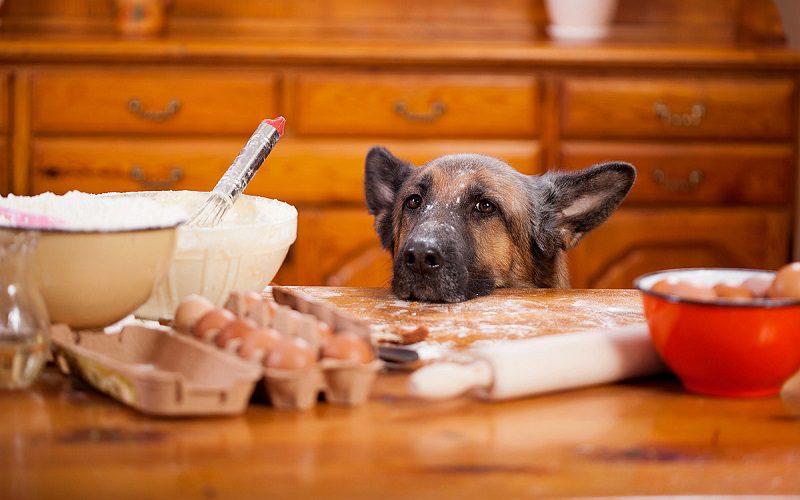
If you don’t like the idea of giving only wet and dry food to your GSD, you can put it on a raw diet. This type of diet is packed with energy, protein, vitamins, and carbohydrates.
You can feed your dog raw meat, or you can choose to bake it. The ingredients you add to the diet should be dog-friendly. You can also add vegetables to the meal (in cooked form).
Feeding a raw diet at an early age will help your pup grow faster. A raw meat diet is also helpful in strengthening the bones and fighting several diseases in GSDs.
Below are the options for meat that you can feed your GSD.
- Meat has a 50%–70% content and should be low-fat.
- Baked or boiled meat is the ideal food for a GSD.
- raw, meaty bones.
- Cooked fish: pink salmon, trout, sardines, and jack mackerel.
- Organs such as the liver should be included in the diet in a small quantity.
- Eggs. Yogurt. Keffir. Cottage and Ricotta Cheese
- Non-poisonous fruits and vegetables.
Wrap-Up
Whether you are feeding your dog canned or dry food, you need to make certain that the food is made from healthy ingredients. A dog’s life expectancy depends 80% on the food it eats.
Maintain quality over quantity, and feed your dog food that is of quality and meets its bodily requirements.
GSD’s are carnivores, and they need a diet that is rich in protein. If you think your dog is not getting enough protein from dry food, switch to canned food.
Similarly, if your dog drinks water after every meal and doesn’t have a dehydration problem, then feeding it dry kibble wouldn’t be a problem.
Resources:



